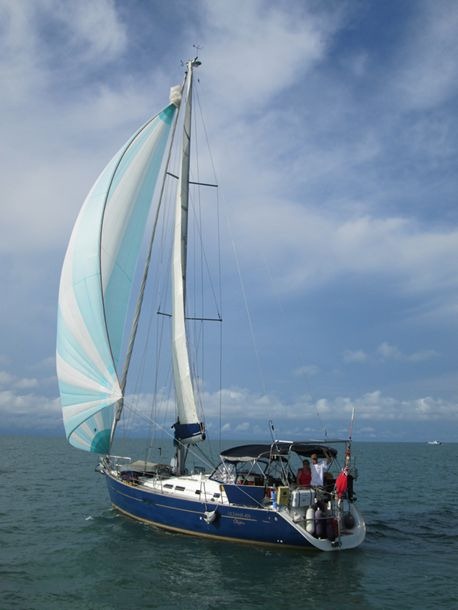Semporna N04 25.121 E118 37.115

|
En route to Semporna After the peace and beauty of Pulau Gaya Lagoon entering Semporna harbour is a shock. It has every imaginable vessel ploughing here, there and everywhere. We stopped to buy some fish from a water gipsy fishing boat not much more than a dug out canoe with extra bits and a defunct outboard motor. They didn't speak Bahasa Malay so communication was near impossible and we managed our purchase by pointing and hand signals, the fish were good indeed. A few minutes later we saw a small open motor boat loaded with new bedding, two children of about 7 & 9 years and a broken down outboard motor. Father was pulling at the outboard starter cord but nothing was happening and they were drifting rapidly backwards. We went over and threw them a tow rope and as we got to the shallow water of the harbour had to set them adrift but thankfully a local boat took over and towed them to shore. We found a good anchor spot in 14 metres just in front of the stilt village which stretched along the water front near the entrance to the inner harbour which dries out at low tide much like Alderney In the Channel Islands. Unlike Alderney a river of the worst kind of rubbish swept past: disposable nappies, plastic bags filled with reeking contents, pieces of old broken furniture, huge old rice sacks and more besides. We anchored with a fellow yachtie from Aus – Seventh Heaven with Charlie and Betty Preen on board. They have been taking a long break from their bare boat charter business down near the Whitsunday Islands on the East Coast of Australia. We took it in turns to go ashore for shopping and garbage disposal. Getting out of the dinghy was a feat as there were no suitable landing places so we had to scrabble over muddy shallows and broken concrete then climb over the fence to the road. Semporna seemed like the wild west, very dirty, very busy, people everywhere looking for a chance to make a Ringgit and plenty of soldiers around with automatic weapons. We found a rubbish skip easily enough but wondered what happened to the contents. Then a supermarket which provided what we needed and the market for a few carefully inspected bits and pieces. A posse of young lads with barrows waited to act as porters and ferried our quite heavy goods back to the dinghy. The lads were nice enough but they had handlers who owned the barrows who were annoying. It is difficult to understand why Semporna is like it is as within its surrounding archipelago of islands are some of the most renowned dive spots in the world so there is a thriving diving tourism industry. The town is used as a stopover before divers and snorkellers leave for the islands so there is plenty of business comprising scuba centres, hotel and backpacker accommodation, a variety of restaurants and eating places, masses of ferries going to and from the islands. The money certainly hasn't been spent on the town or the harbour, the only pleasant part were the park and garden areas around the mosque. In Malaysia, as in Indonesia and other asian countries, people were used to carrying their goods home in woven rattan baskets and wrapped in banana leaves, here they still sell take away cooked rice and some other fast foods like this. Their rubbish was mainly biodegradable so instant disposal was not a big issue and old habits die hard. However, in the towns and larger villages all the supermarkets and fresh markets use plastic bags. We always take our own bags but in most of the supermarkets if you do this every item has to be stuck with a sticky plastic strip to show it has been paid for, the process takes ages and the till operators don’t like it but we wait. Also people are demanding better standards as they are across the world therefore lots of products are triple wrapped to keep out weevils and bugs so there is plenty of discarded wrapping from almost every purchase. Kentucky Fried Chicken dominates lots of the towns in Malaysia and the polystyrene packaging is everywhere, it floats in all the harbours and out to sea, it can be seen miles out - KFC and similar providers have a lot to answer for. With little or no recycling in place and a sometimes ineffective garbage collection and disposal system the country has a serious plastic problem that will need much investment and will probably take years to sort out. We didn't linger in the flowing rubbish. After managing to remove a rice sack from the propeller (yes, it did happen) we spent a couple of hours making our way upstream to a clean and tranquil basin which we discovered was part of an anchorage for the Malaysian Navy. We were visited by a patrol boat and they were charming, they wanted all our details and itinerary but were happy to provide security as we were still in the heart of the alert area for Filipino insurgency so they let us lie at anchor giving us cheery waves as they went by with their armoury of weapons. The good relations we have continued to have with the Maritim Polis and armed forces in Malaysian Borneo has been a really pleasant surprise and very reassuring. |
